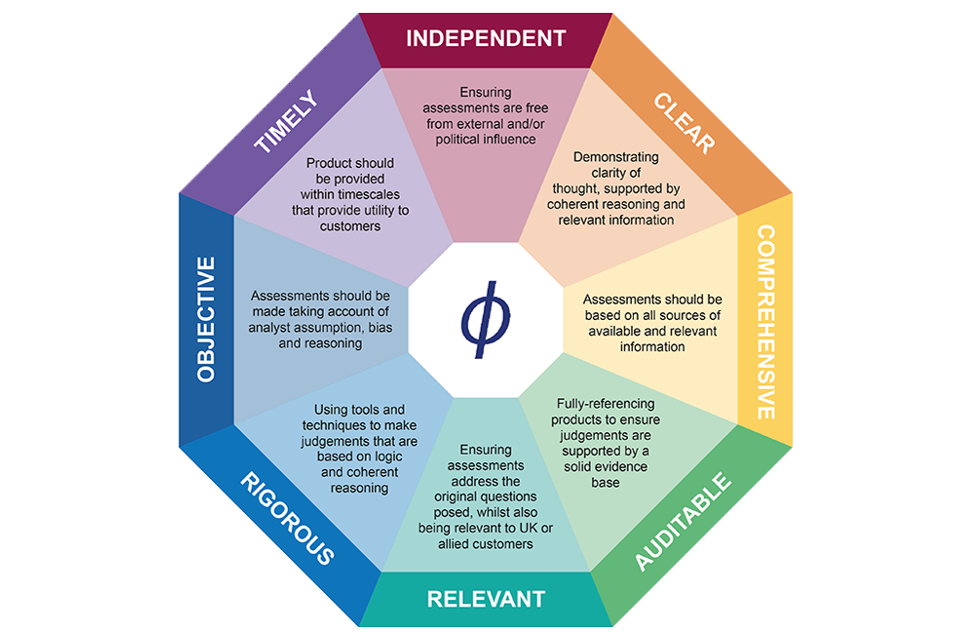PHIA Common Analytical Standards
Published 24 March 2025
Common Analytical Standards ensure a consistent standard of rigour, integrity, language and best practice across the UK intelligence assessment community. The high-level standards set out below can be developed, and expanded upon, by individual assessment organisations to reflect their requirements and best procedures.
Independent: Ensuring assessments are free from external and/or political influence.
Clear: Demonstrating clarity of thought, supported by coherent reasoning and relevant information.
Comprehensive: Assessments should be based on all sources of available and relevant information.
Auditable: Fully-referencing products to ensure judgements are supported by a solid evidence base.
Relevant: Ensuring assessments address the original questions posed, whilst also being relevant to UK or allied customers.
Rigorous: Using tools and techniques to make judgements that are based on logic and coherent reasoning.
Objective: Assessments should be made taking account of analyst assumption, bias and reasoning.
Timely: Product should be provided within timescales that provided utility to customers.

Independent
Assessments should be free from external and/or political influence; they should not be distorted by, nor shaped for, a particular agenda or policy/operational viewpoint or preference. Analysts should avoid being influenced by policy or operational objectives and must resist any pressure, or perceived pressure, deliberate or not, to mould information and analysis to a desired assessment.
Clear
It is best practice to include a set of “Key Judgements” or an “Executive Summary” that ensures that a consumer can extract the most pertinent judgements quickly from an assessment product. Analytical products should demonstrate clarity of thought by presenting clear and consistent assessments supported by coherent reasoning and relevant information. This should include contradictory information where it significantly affects judgements.
- Information and assumptions. Analytical products should clearly distinguish judgements that rely on available information from judgements that rely exclusively on assumptions to frame or support a hypothesis, or fill a key information gap. Analysts may state explicitly where an assumption serves as the lynchpin for a judgement or when they are used to fill a key information gap. Analysts should understand the implications for an assessment if assumptions are proven incorrect.
- Uncertainty. Analysts should express and explain probabilistic language associated with judgements using the Probability Yardstick. The meaning of any alternative probabilistic language should be stated and explained. A robust Analytical Confidence Method should be employed to make explicit the quality of the information and the analytical process employed in generating judgements. Where appropriate, analysts should identify indicators and collection opportunities that would alter their levels of uncertainty, especially in relation to key judgements.
- Explain change. Analysts should state how their key judgements are consistent with, or represent a change from, those in previously published assessments. Significant differences in analytical judgement, such as between two government departments or intelligence organisations, should be considered and communicated to customers where concurrence cannot be achieved.
Comprehensive
Assessments should be based on all sources of available and relevant information. Analysts should consider the impact that coverage, completeness, quality, credibility, reliability, age/currency, and possible denial and deception have on their analysis. Analysts should communicate within the assessment which sources are most important to their key analytical judgements and identify critical information gaps.
Where appropriate, analysts must include a description of the strengths and weaknesses of the overall intelligence base in confidence statements or an “assessment base”.
Auditable
Analysts should produce and retain a fully referenced version of their products for audit purposes. The main evidence underpinning each judgement, as well as contradictory information that affects a judgement, should be footnoted and/or endnoted. Analysts should record the use of any methods or techniques and may make reference to them in the product.
Relevant
Analytical products should provide information and insights that are relevant to UK or allied customers. Customarily, a product should explicitly reference a customer requirement to which the assessment responds.
Assessments should address the questions posed. Occasionally, assessment bodies may anticipate a customer requirement and produce an assessment without an explicit tasking, especially in the realm of early warning.
Rigorous
Analysts should use processes, methods, tools and techniques appropriate to the intelligence requirement in order to be able to show logical and coherent reasoning upon which the resulting judgements are based.
Analysts should identify and systematically evaluate differing hypotheses, especially when judgements contain significant levels of uncertainty or complexity (such as forecasting future trends), or when low probability outcomes would have high impact results. This activity should be recorded in a discoverable format for the audit trail.
Objective
Analysts should demonstrate awareness of their own assumptions, biases and reasoning. Analysts should be able to conceive of information or events that, in principle, would contradict their hypothesis and should reconsider their judgements in light of new developments or information. Analytical judgements should be falsifiable (empirically testable as opposed to tautological or truistic), containing a hypothesis, verbal probability, and timeframe. Analysts should consider the use of structured techniques that promote objectivity and de-biasing. They should present the outcomes of their analysis honestly, even if the assessments are contentious.
Timely
Analytical product should be provided in time for it to be of utility to customers. Analysts should be aware of events and changing intelligence requirements and priorities, and monitor customer activities and plans to remain as agile as possible.
